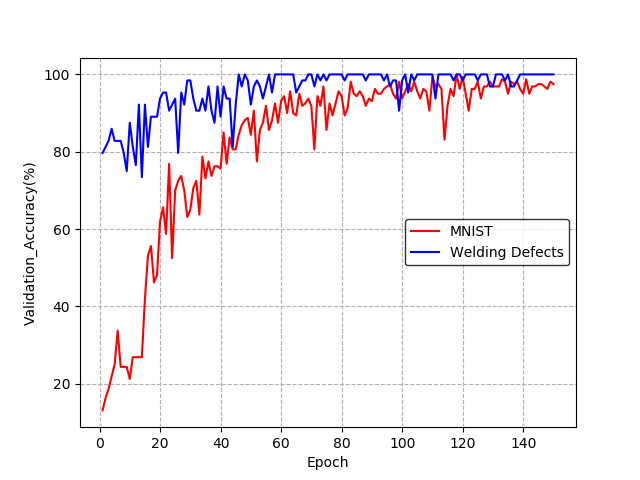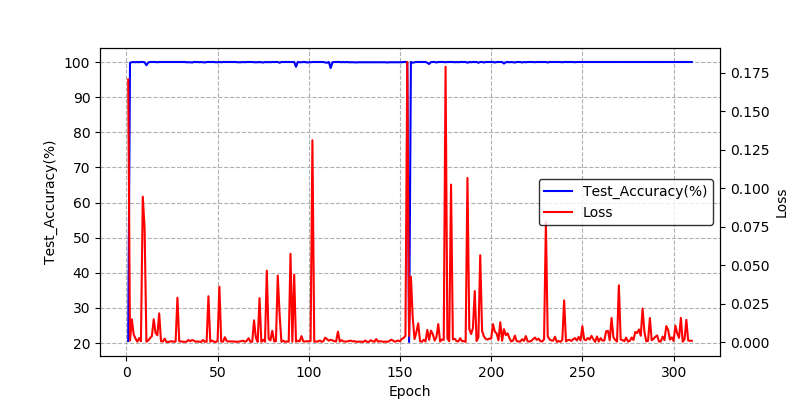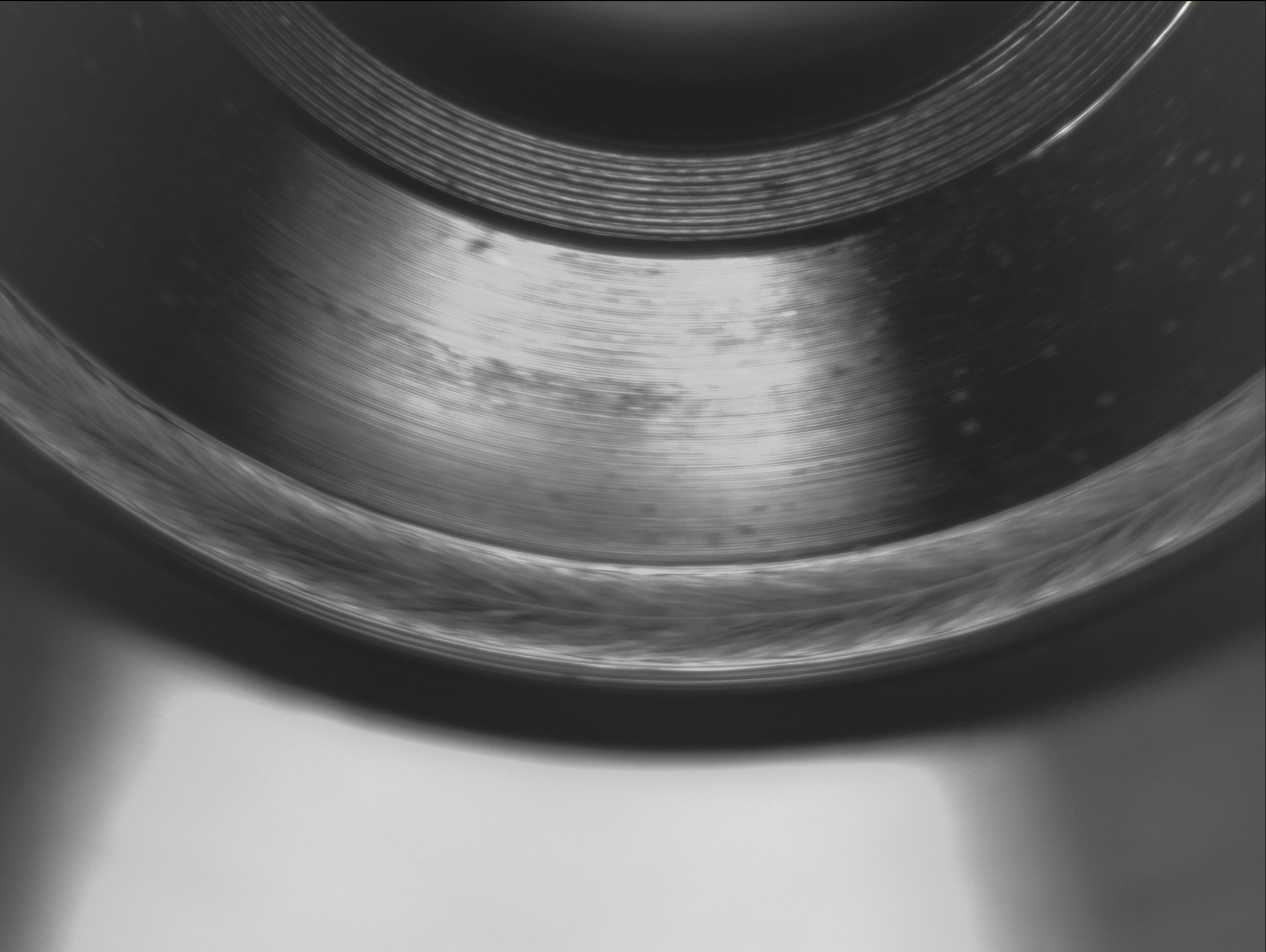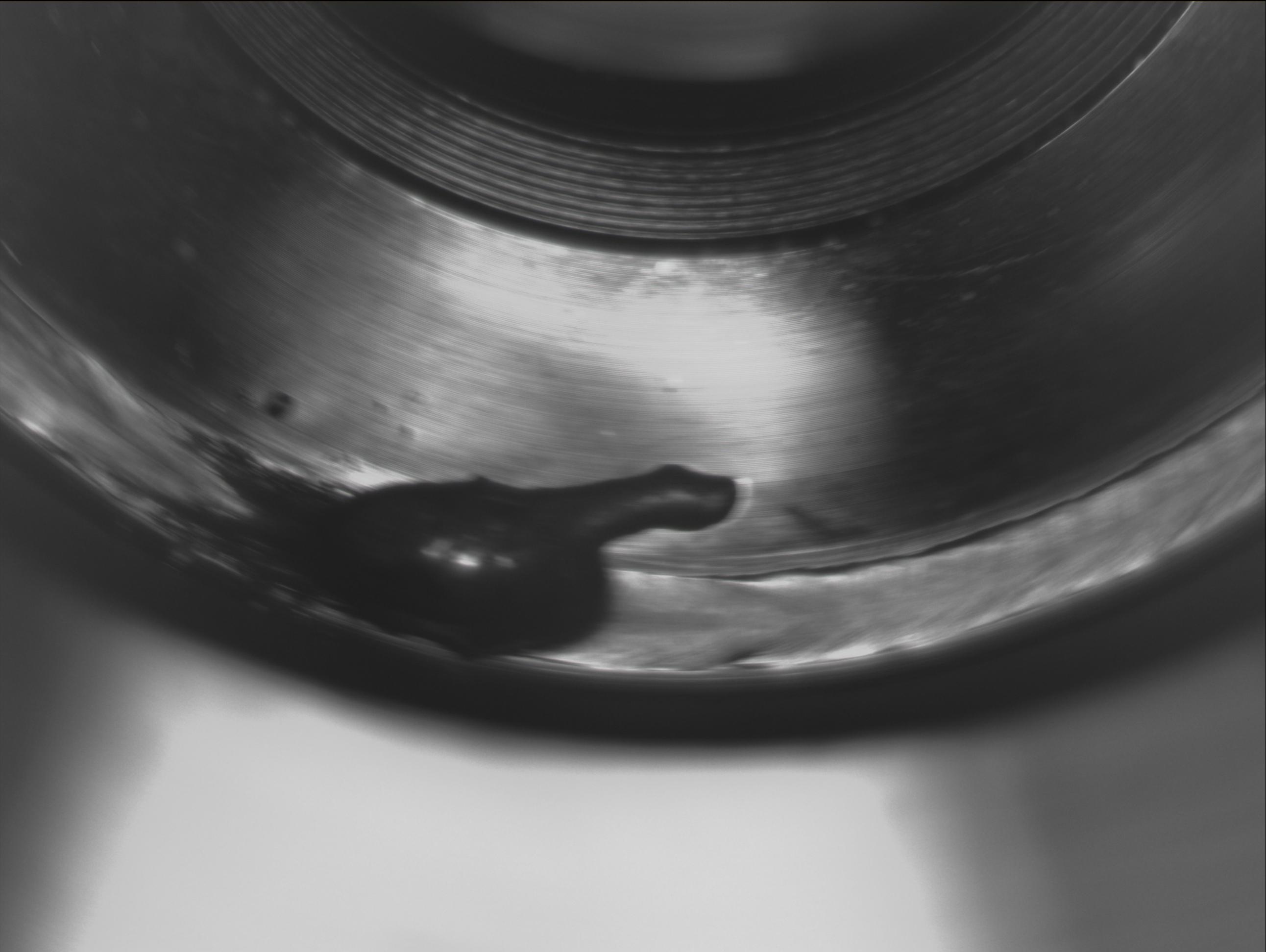I will explain the code of Efficient Neural Architecture Search(ENAS), especially case of micro search.
Unlike the author's code, This code can work in a windows 10 enviroment and you can use png files as datasets.
Also you can apply data augmentation using "n_aug_img" which is explained below.
-
OS: Window 10(Ubuntu 16.04 is possible)
-
Graphic Card /RAM : 1080TI /32G
-
Python 3.5
-
Tensorflow-gpu version: 1.4.0rc2
-
OpenCV 3.4.1
At first, you should unpack the attached data as shown below.
Next, You should change the code below to suit your situation.
<main_controller_child_trainer.py and main_child_trainer.py>
DEFINE_string("output_dir", "./output" , "")
DEFINE_string("train_data_dir", "./data/train", "")
DEFINE_string("val_data_dir", "./data/valid", "")
DEFINE_string("test_data_dir", "./data/test", "")
DEFINE_integer("channel",1, "MNIST: 1, Cifar10: 3")
DEFINE_integer("img_size", 32, "enlarge image size")
DEFINE_integer("n_aug_img",1 , "if 2: num_img: 55000 -> aug_img: 110000, elif 1: False")
It is recommended to set "n_aug_img" = 1 to find the child network, and to use 2 ~ 4 to train the found child network.
Then, You can train Controller of ENAS with the following short code:
python main_controller_child_trainer.py
After finishing, you can train the child network with the following code:
Case of MNIST
python main_child_trainer.py --child_fixed_arc "1 2 1 3 0 1 0 4 1 1 1 1 0 1 0 1 1 0 0 1 0 1 0 4 1 0 2 0 0 3 1 1 0 0 0 0 4 1 1 0"
Case of Cifar 10
python main_child_trainer.py --child_fixed_arc "1 0 1 1 1 1 0 0 1 1 0 0 0 3 0 3 1 3 1 1 1 1 0 3 0 3 0 3 1 3 0 1 1 3 0 2 0 3 1 0"
Case of Welding Defects
python main_child_trainer.py --child_fixed_arc "1 0 0 1 0 0 1 1 2 2 1 1 1 1 1 2 1 0 0 0 0 0 0 3 2 2 1 0 2 0 2 3 0 3 4 0 1 0 3 2"
The string in the above code like "1 2 1 3 0 1 ~ " is the result of main_controller_child_trainer.py
The first 20 numbers are for the architecture for convolution layers, and the rest are for pooling layers.
After training <main_controller_child_trainer.py>, we got the following child_arc_seq and visualized it as shown below.
"1 2 1 3 0 1 0 4 1 1 1 1 0 1 0 1 1 0 0 1 0 1 0 4 1 0 2 0 0 3 1 1 0 0 0 0 4 1 1 0"
"1 0 1 1 1 1 0 0 1 1 0 0 0 3 0 3 1 3 1 1 1 1 0 3 0 3 0 3 1 3 0 1 1 3 0 2 0 3 1 0"
"1 0 0 1 0 0 1 1 2 2 1 1 1 1 1 2 1 0 0 0 0 0 0 3 2 2 1 0 2 0 2 3 0 3 4 0 1 0 3 2"
MNIST
Test Accuracy : 99.77%
CIFAR 10
Test Accuracy :
Welding Defects
Test Accuracy : 100.00%
| Controller Validation Accuracy(reward) |

|
| ChildNetwork Loss & Test Accuracy for MNIST Dataset |

|
| ChildNetwork Loss & Test Accuracy for Welding Defects Dataset |

|
First, we will build the sampler as shown in the picture below.
Then we will make controller using sampler's output "next_c_1, next_h_1".
After getting the "next_c_5, next_h_5", you must do the following to renew "Anchors, Anchors_w_1".
To enable the Controller to make better networks, ENAS uses REINFORCE with a moving average baseline to reduce variance.
<micro_controller.py>
for all index:
curr_log_prob = tf.nn.sparse_softmax_cross_entropy_with_logits(logits=logits, labels=index)
log_prob += curr_log_prob
curr_ent = tf.stop_gradient(tf.nn.softmax_cross_entropy_with_logits(
logits=logits, labels=tf.nn.softmax(logits)))
entropy += curr_ent
for all op_id:
curr_log_prob = tf.nn.sparse_softmax_cross_entropy_with_logits(logits=logits, labels=op_id)
log_prob += curr_log_prob
curr_ent = tf.stop_gradient(tf.nn.softmax_cross_entropy_with_logits(
logits=logits, labels=tf.nn.softmax(logits)))
entropy += curr_ent
arc_seq_1, entropy_1, log_prob_1, c, h = self._build_sampler(use_bias=True) # for convolution cell
arc_seq_2, entropy_2, log_prob_2, _, _ = self._build_sampler(prev_c=c, prev_h=h) # for reduction cell
self.sample_entropy = entropy_1 + entropy_2
self.sample_log_prob = log_prob_1 + log_prob_2 <micro_controller.py>
self.valid_acc = (tf.to_float(child_model.valid_shuffle_acc) /
tf.to_float(child_model.batch_size))
self.reward = self.valid_acc
if self.entropy_weight is not None:
self.reward += self.entropy_weight * self.sample_entropy
self.sample_log_prob = tf.reduce_sum(self.sample_log_prob)
self.baseline = tf.Variable(0.0, dtype=tf.float32, trainable=False)
baseline_update = tf.assign_sub(
self.baseline, (1 - self.bl_dec) * (self.baseline - self.reward))
with tf.control_dependencies([baseline_update]):
self.reward = tf.identity(self.reward)
self.loss = self.sample_log_prob * (self.reward - self.baseline)(1) Schematic of Child Network
(2) _enas_layers
<micro_child.py>
def _enas_layers(self, layer_id, prev_layers, arc, out_filters):
'''
prev_layers : previous two layers. ex) layers[●,●]
●'s shape = [None, H, W, C]
arc: "0 1 0 1 0 3 0 0 2 2 0 2 1 0 0 1 1 3 0 1 1 1 0 1 0 1 2 1 0 0 0 0 0 0 1 3 1 1 0 1"
out = [self._enas_conv(x, curr_cell, prev_cell, 3, out_filters),
self._enas_conv(x, curr_cell, prev_cell, 5, out_filters),
avg_pool,
max_pool,
x]
'''
retrun output # calculated by arc, np.shape(output) = [None, H, W, out_filters]
# if child_fixed_arc is not None, np.shape(output) = [None, H, W, n*out_filters]
# where n is the number of not being used nodes in the coonv cell or Reduction cell.(3) factorized_reduction
<micro_child.py>
def factorized_reduction(self, x, out_filters, strides = 2, is_training = True):
'''
x : x is last previous layer's output.
out_filters: 2*(previous layer's channel)
'''
stride_spec = self._get_strides(stride) # [1,2,2,1]
# Skip path 1
path1 = tf.nn.avg_pool(x, [1, 1, 1, 1], stride_spec, "VALID", data_format=self.data_format)
with tf.variable_scope("path1_conv"):
inp_c = self._get_C(path1)
w = create_weight("w", [1, 1, inp_c, out_filters // 2])
path1 = tf.nn.conv2d(path1, w, [1, 1, 1, 1], "VALID", data_format=self.data_format)
# Skip path 2
# First pad with 0"s on the right and bottom, then shift the filter to
# include those 0"s that were added.
if self.data_format == "NHWC":
pad_arr = [[0, 0], [0, 1], [0, 1], [0, 0]]
path2 = tf.pad(x, pad_arr)[:, 1:, 1:, :]
concat_axis = 3
else:
pad_arr = [[0, 0], [0, 0], [0, 1], [0, 1]]
path2 = tf.pad(x, pad_arr)[:, :, 1:, 1:]
concat_axis = 1
path2 = tf.nn.avg_pool(path2, [1, 1, 1, 1], stride_spec, "VALID", data_format=self.data_format)
with tf.variable_scope("path2_conv"):
inp_c = self._get_C(path2)
w = create_weight("w", [1, 1, inp_c, out_filters // 2])
path2 = tf.nn.conv2d(path2, w, [1, 1, 1, 1], "VALID", data_format=self.data_format)
# Concat and apply BN
final_path = tf.concat(values=[path1, path2], axis=concat_axis)
final_path = batch_norm(final_path, is_training, data_format=self.data_format)
return final_path(4) _maybe_calibrate_size
<micro_child.py>
def _maybe_calibrate_size(self, layers, out_filters, is_training):
"""Makes sure layers[0] and layers[1] have the same shapes."""
hw = [self._get_HW(layer) for layer in layers]
c = [self._get_C(layer) for layer in layers]
with tf.variable_scope("calibrate"):
x = layers[0]
if hw[0] != hw[1]:
assert hw[0] == 2 * hw[1]
with tf.variable_scope("pool_x"):
x = tf.nn.relu(x)
x = self._factorized_reduction(x, out_filters, 2, is_training)
elif c[0] != out_filters:
with tf.variable_scope("pool_x"):
w = create_weight("w", [1, 1, c[0], out_filters])
x = tf.nn.relu(x)
x = tf.nn.conv2d(x, w, [1, 1, 1, 1], "SAME", data_format=self.data_format)
x = batch_norm(x, is_training, data_format=self.data_format)
y = layers[1]
if c[1] != out_filters:
with tf.variable_scope("pool_y"):
w = create_weight("w", [1, 1, c[1], out_filters])
y = tf.nn.relu(y)
y = tf.nn.conv2d(y, w, [1, 1, 1, 1], "SAME", data_format=self.data_format)
y = batch_norm(y, is_training, data_format=self.data_format)
return [x, y](5) Others
You can see more details of the child network in <micro_child.py>
<main_child_controller_trainer.py>
1. Train the Child Network during 1 Epoch. (Momentum optimization)
※ 1 Epoch = (Total data size / batch size) times parameters update.
2. Train the controller 'FLAGS.controller_train_steps x FLAGS.controller_num_aggregate' times. (Adam Optimization)
3. Repeat "1", "2" as many as we want.(160 Epochs)
4. Choose the child network architecture with the highest validation accuracy.
<main_child_trainer.py>
1. Train the child Network which is selected above as many as we want. (Momentum optimization, 660 Epochs)
def aug(image, idx):
augmentation_dic = {0: enlarge(image, 1.2),
1: rotation(image),
2: random_bright_contrast(image),
3: gaussian_noise(image),
4: Flip(image)}
image = augmentation_dic[idx]
return imageFunction enlarge, rotation, random_bright_contrast and Flip are writen using cv2.
In the case of MNIST Data, I do not apply flip! you can check more details in <data_utils.py>
| Welding OK | Welding NG |

| 
|
Paper: https://arxiv.org/abs/1802.03268
Autors' implementation: https://github.com/melodyguan/enas
Data Pipeline: https://github.com/MINGUKKANG/MNIST-Tensorflow-Code
All rights related to this code are reserved to the author of ENAS
(Hieu Pham, Melody Y. Guan, Barret Zoph, Quoc V. Le, Jeff Dean)















